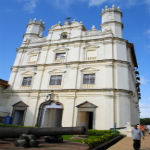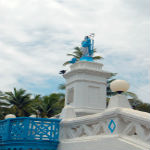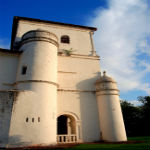In the Northern Goa district lies the historical city of Vedha Goa or Old Goa (vedha in Portuguese means "old"). Panjim, the capital city of Goa, is about ten kilometers west of Old Goa. The city of Old Goa was constructed in the 15th century by the Bijapur Sultanate.
From 16th century till its abandonment due to plague in the 18th century, it was the capital of Portuguese India. The city still holds the churches and covenants of those times, which reflect the Portuguese culture clearly. The architectural styles of these monuments of historical significance depict a combination of Renaissance and Baroque styles and the main materials used to construct these churches are laterite and plaster. Labeled as "Rome of the East" and "Golden Goa", this city has been marked by UNESCO as a World Heritage Site.
History
The churches and covenants of Old Goa are remnants of the existence of Portuguese rule in the area. The 16th and 17th centuries saw the construction of several cathedrals and churches, including Basilica of Bom Jesus , Se Cathedral, Church of Lady of Rosary, Church of St. Francis of Assisi and Church of St. Augustine. These churches are affiliated to different congregations. The churches are aesthetically designed and consist of paintings done on wooden borders that were fixed between beautifully designed floral panels. These institutions and magnificent buildings are legacies of the Portuguese culture and social life, and are still maintained by the Christians of this area. In Goa educational contribution of the churches is immense. All of these are now a part of Archdiocese of Goa, most of which are declared as protected sites.
The monuments are open on all the days, including public, state and national holidays, from sunrise to sunset.
Some of the most famous Churches in Goa are listed below:
- Church of St. Francis Of Assisi, Old Goa: The Portuguese built the Church of St. Francis of Assisi in 1661. This church lies on the western side of Se Cathedral, with the Palace of the Archbishop in-between. Laterite blocks were used in its construction that is lime-plastered. The convent, which is an annexure of the church, houses an archaeological museum. The statue of St. Francis of Assisi, made of wood, embellishes the pedestal that bears the emblem of Franciscans. A statue of Our Lady of Miracles, brought from Jaffna, Sri Lanka, adorns the facade. The statues of St. Peter, St. Michael and St. Paul are also seen here. Painted panels portraying the life of St. Francis of Assisi are retained on the adjoining walls.
- Basilica of Bom Jesus, Old Goa: Goa's most famous Jesuit church, the Basilica of Bom Jesus, situated in Old Goa, is the first minor basilica in India. The church is dedicated to Bom Jesus, meaning infant or good Jesus. This model of elegance and simplicity, now in ruins, is the most revered church in the Christian community worldwide. Jesuit architecture is quite apparent from its design and structure. The consecration of the church was done by the then Archbishop of Goa, Fr. Alexia de Menezes upon its completion on 15 May 1605. The facade of the church has the letters 'HIS' inscribed on it, that are the first three letters of Lord Jesus Christ in Greek. The figure of infant Jesus is placed on the main altar that is richly glided. A large statue of St. Ignatius Loyola, founder of the Jesuits, is above the altar. The chapel of the Blessed Sacrament is placed in the transept that is on the northern side. The mortal remains of St. Francis Xavier are kept intact in a decorated casket in the basilica.
- Sunday: 10:30 a.m. to 6:30 p.m.
- Weekdays: 9:00 a.m. to 6:30 p.m.
- Sunday mass: 8 a.m. and 9:15 a.m.
- Weekdays mass: 7 a.m. and 8 a.m.
- Ruins of Church of St. Augustine: Half a kilometer away from the Se Cathedral lies the beautiful St. Cajetan Church. Modeled as the Basilica of St. Peter of Rome, this church reflects Corinthian architecture. The richly carved glided altars are made following the Baroque style. The church is dedicated to Our Lady of Divine Providence and is named after St. Cajetan, the founder of order of Theatine, who was a contemporary of St. Francis Xavier. The church was built by Italian friars in 1661. The altars of the church are decorated with Italian-school paintings, some of which depicts the life of St Cajetan.
- St. Cajetan Church, Old Goa: The St Cajetan Church is located in Old Goa. It is famous for the high vault on which are inscribed the words of Christ 'My House Is a House of the Words of Christ". St Cajetan, lies about half a km away to the north east of the Se Cathedral and close to the ruins of the Viceregal Palace.
- Church of Mary Immaculate Conception: The church was one of the first to be built in Goa, certainly being there by 1541.
- Lady Rosary Church: On the western side of the Holy Hill, called Monte Santo, lies the Church of Our Lady of Rosary. The church gives an excellent view of the Mandovi River and Divar Island. History evidences that in 1510, Alfonso de Albuquerque organized his army at this site and eventually became victorious. This church holds a high regard as St. Francis Xavier imparted his teachings here to the locals. The main altar has the image of the Lady of Rosary.
- Chapel of St. Catherine, Old Goa or the Se Cathedral Church: Se Cathedral, considered the biggest Roman Catholic Church in Asia, is one of the ancient and most popular churches in Old Goa. According to history, Alfonso Albuquerque in 1510 defeated the Muslim army on the feast day of St. Catherine of Alexandria and took possession of Goa. Statistics available say that this 16th-century monument took 80 long years to complete. Also called St. Catherine's Cathedral, devoted to Catherine of Alexandria, this church with excellent tradition holds a high place of sacredness and respect among the Christians across the world. It is a UNESCO World Heritage Site that clearly reflects the Portuguese Manueline style of architecture and royalty. The Golden Bell, famous for its rich tone and large size, is housed in the Cathedral's tower. Apart from the altar that is dedicated to Catherine of Alexandria, the other attraction is a chapel of the Cross of Miracles that is housed on the right side. It is said that in 1919, a vision of the Christ appeared on the chapel.
- Sunday mass: 7:15 a.m., 10 a.m. and 4 p.m.
- Weekdays mass: 7:30 a.m. and 6 p.m.
- The Church of St Anne at Talaulim Ilhas: This Church is most notable for its excellent architecture.
- Reis Magos Church: The small hamlet of Reis Magos lies on banks of the Mandovi River and is home to two famous landmarks of Goa - the Reis Magos fort and the Reis Magos Church. This church is dedicated to the Three Wise Men or the Three Magi who were the first to give offerings to the Child Jesus. 'Reis Magos' directly translates as 'Magi King'.
- Chapel and Tomb of St. Francis Xavier: The Chapel and Tomb of St. Francis Xavier is a plain chapel with only one altar and is built of laterite blocks and is plastered with lime.
- Church of St Paul: The Church of St Paul was started as a seminary of the Holy Faith for training young converts by two priests Diogo de Borba and Miguel Vaz who had established the Santa Fe confraternity.
- Holy Spirit Church: It is one of the most religiously important and architecturally brilliant churches built in Goa.
- St. Augustine Tower: St. Augustine Tower is one of the spectacular monuments in Old Goa. Served as a belfry, this 46-meter-high four-storied magnificent tower forms part of the facade of the St. Augustine Church. It was built by the Augustinian friars in 1602. The church was built by 12 Augustine friars, the construction of which was finished in 1602. The church is in ruins today, with the bell tower being the only remains of the site. However, sometime between 1841 and 1871 the bell of the tower was removed and kept at Fort Aguada Light House. Later it was transferred to Panaji in the Lady of Immaculate Conception Church.
Weekdays: 07:00 to 08:00 hrs.
Sundays: 08:00 to 09:15 hrs.
Last Updated on: November 13, 2025
Places to see in Goa







